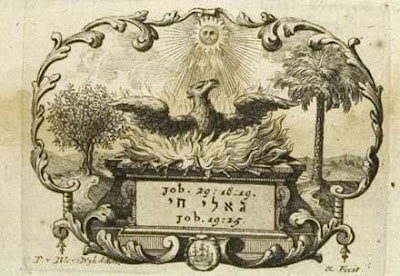The Phoenix in the Catholic Tradition
Several years ago I was reading 1 Clement and I was alarmed that St. Clement (the fourth pope) seemed to believe that the phoenix was a real animal. Moreover, St. Clement uses the phoenix as a sign of Christ’s resurrection.
Let us consider that wonderful sign [of the resurrection] which takes place in eastern lands, that is, in Arabia and the countries round about. There is a certain bird which is called a phoenix. This is the only one of its kind, and lives five hundred years. And when the time of its dissolution draws near that it must die, it builds itself a nest of frankincense, and myrrh, and other spices, into which, when the time is fulfilled, it enters and dies. But as the flesh decays a certain kind of worm is produced, which, being nourished by the juices of the deed bird, brings forth feathers. Then, when it has acquired strength, it takes up that nest in which are the bones of its parent, and bearing these it passes from the land of Arabia into Egypt, to the city called Heliopolis. And, in open day, flying in the sight of all men, it places them on the altar of the sun, and having done this, hastens back to its former abode. The priests then inspect the registers of the dates, and find that it has returned exactly as the five hundredth year was completed. (1 Clement 25)
Was Clement nuts or was he speaking from a valid tradition?
As it turns out, the tale of the phoenix is actually found in the Bible’s oldest book – the book of Job. Job 29:18 reads,
Then I said: ‘I shall die with my nest, and I shall multiply my days as the phoenix.’
Clement’s idea that the phoenix dies and its nest and the returns for a length of days has its origin here.
The Hebrew translation is debated. The Hebrew word chol is typically translated in one of three different ways:
1. sand
2. phoenix, as in the mythical bird
3. palm tree
In nearly every context, the Hebrew word chol means “sand.” We should expect then that to be the Jewish interpretation. But instead, the post-Christian rabbis have almost unanimously interpreted the passage in Job as referring to the mythical bird, the phoenix. The midrashic document the Genesis Rabba or Bereshit Rabba (19:5) explains that Eve “gave the cattle, beasts, and birds to eat of [the forbidden fruit]. All obeyed her and ate thereof, except a certain bird named chol, as it is written, “Then I said: I shall die with my nest, and I shall multiply my days as the chol.” (Job 29:18). The Genesis Rabba was composed no later than A.D. 450. From this point on, Jewish rabbinical scholars (e.g. Rashi) simply assume that Job 29:18 is speaking of the phoenix bird that is able to rise from the ashes. In fact, if you consult almost any Jewish translation of Job, you will find that Job 29:18 has been translated as referring to the “phoenix” and not “sand.”
The Septuagint oddly presents the Hebrew word chol as with the Greek word phoinikos, which technically refers to the palm tree. Yet it is very close to the Greek word phoinix or “phoenix.” Some believe that the original word of Job 29:18 in the Septuagint tradition was in fact “phoenix.” It is difficult to understand how a Hebrew word meaning “sand” came to be translated as phoinikos or “palm tree.” Given the prevalence of the Jewish tradition of the phoenix reading, I think that the original text likely read phoinix or “phoenix” and that early on it was later corrected by a sober copyist as phoinikos or “palm tree” so as to avoid a rather embarrassing interpretation that Job believed that a bird died in its nest and rose again.
So it goes like this. Job 29:18 originally had an obscure reference to Job dying in “his nest” and then multiply his days “like sand.” Probably through Hellenic influence, the mythical idea of the phoenix was read into the passage. The idea of death and new life in the context of “death and rebirth in the nest” was just to juicy to leave alone after readers new about the mythical tradition of the phoenix bird. Thus, the Septuagint translated the passage as referring to the “phoenix” and not “sand.” Then later the Septuagint passage was mistakenly corrected, not by returning to the “sand” translation but by altering the word toward an entirely new concept – that of the “palm tree” or phoinikos.
In case you’re interested, St. Jerome later translated the term in Latin as palma or “palm tree.” I wonder if he looked at the Hebrew or not.
St. Clement in 1 Clement likely had Job 29:18 in mind because he quotes Job just after describing his chapter on the phoenix (25). He does not quote the Job 29:18 passage directly, but still Clement quotes Job to prove the long expected hope of the resurrection. It is not surprising then to conclude that St. Clement’s phoenix sermon illustration for the resurrection of the dead also has its origins in Job.
What to Watch Next
SHOP THE TAYLOR MARSHALL STORE
Dive Deeper

GET CONFIDENT IN YOUR FAITH
Explore the fascinating world of Catholic teachings with Dr. Marshall. Together you’ll unpack the brilliant answers the Church gives to tough questions about the Faith. The best part: you go at your own pace. Start this exciting journey today.


 >
>



